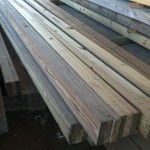Presenting actual factual evidence, from a peer reviewed and published study seems to have little bearing upon reality in today’s social media influenced world.
Instead, people tend to rely heavily upon those with a vested (financial) interest in promotion of something other than actual and factual truth. Those invested interests vary from those selling alternatives to properly pressure preservative treated lumber (various lumber protection products, precast concrete piers, brackets, etc.) to competing building structural systems (PEMBs, weld ups, etc.).
In reality, I know a couple people in either lumber or post frame building industries. Having spent my entire adult life in these tends to add to those I know. I have yet to meet anyone, who can prove to me they have actually experienced a properly pressure preservative treated wood building column rot.
Zero.
Of course there are always those who have stories such as, “My Uncle’s cousin says he knows of somebody, who knew somebody who had all of their pole barn poles rot off”. Could be – and those poles were most probably inadequately treated (or maybe not at all).
In order to put this matter to rest and ease my already untroubled mind, I utilized Google to do some research.
Well, it turns out four fine people named Stan Lebow, Bessie Woodward, Grant Kirker and Patricia Lebow got their collective thinking caps together and authored an article entitled “Long-Term Durability of Pressure-Treated Wood in a Severe Test Site”. Said article was published in Advances in Civil Engineering Materials, Vol. 2 No. 1, 2013 on pages 178-188 (for those of you who want to read it in its full and unabridged glory: https://www.fpl.fs.fed.us/documnts/pdf2013/fpl_2013_lebow001.pdf).
Our team of authors was motivated, as stated in this article’s introduction, by this:
“Pressure-treated wood has been widely used as a durable construction material in the United States for over a century. However, despite its long history of use, there are relatively few reports on the long-term decay and insect resistance of pressure-treated wood”.
Now, as it so happens, USDAFS (U.S. Department of Agriculture Forest Service) has a test site located near Saucier, Mississippi.
You ever been to Saucier, Mississippi?
This plot has a relatively high annual rainfall (67 inches average) and warm temperatures (average high temperatures are 80 degrees F. or more from May until November) creating a harsh decay environment. Eastern subterranean termites are active at this site. Bugs, heat, water – you have it all! This location is within American Wood Protection Association (AWPA) Deterioration Zone 5, Severe Hazard – there is no greater severe hazard classification.
As a control, some untreated posts were placed and all failed in less than three years!
 Current Building Code standard for pressure-preservative treated lumber for structural use is UC-4B (read one of my better articles of all time regarding pressure-preservative treating here: https://www.hansenpolebuildings.com/2012/10/pressure-treated-posts-2/). UC-4B requires a chemical retention for many water borne treatments such as ACZA, CCA-B and CCA-C of 0.60 lb/ft^3 (pounds of chemical per cubic foot of lumber). With retention levels LESS than this current UC-4B requirement, there have been ZERO failures in these chemically treated woods in tests of well over 60 years!
Current Building Code standard for pressure-preservative treated lumber for structural use is UC-4B (read one of my better articles of all time regarding pressure-preservative treating here: https://www.hansenpolebuildings.com/2012/10/pressure-treated-posts-2/). UC-4B requires a chemical retention for many water borne treatments such as ACZA, CCA-B and CCA-C of 0.60 lb/ft^3 (pounds of chemical per cubic foot of lumber). With retention levels LESS than this current UC-4B requirement, there have been ZERO failures in these chemically treated woods in tests of well over 60 years!
When will those properly pressure preservative treated timbers rot?
Impossible – no, however probably not within your grandchildren’s grandchildren’s lifespans.
And there you have it, research and all.
 Adhesives used in modern glulams are extremely durable and are considered waterproof. Glulam timbers treated after bonding will accept treatment and resist decay similar to treated sawn timbers of the same species and will perform similarly in service. If the appearance of this product is acceptable to the consumer, it can be used successfully in applications where treated wood is required. Provided the structural requirements of the application are met (meaning – was the right size and grade of pole selected for factors such as wind speed, snow load, etc.), treated glulam timbers can be used in place of treated sawn timbers.
Adhesives used in modern glulams are extremely durable and are considered waterproof. Glulam timbers treated after bonding will accept treatment and resist decay similar to treated sawn timbers of the same species and will perform similarly in service. If the appearance of this product is acceptable to the consumer, it can be used successfully in applications where treated wood is required. Provided the structural requirements of the application are met (meaning – was the right size and grade of pole selected for factors such as wind speed, snow load, etc.), treated glulam timbers can be used in place of treated sawn timbers.





